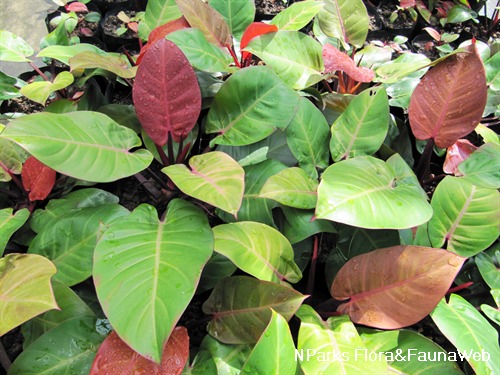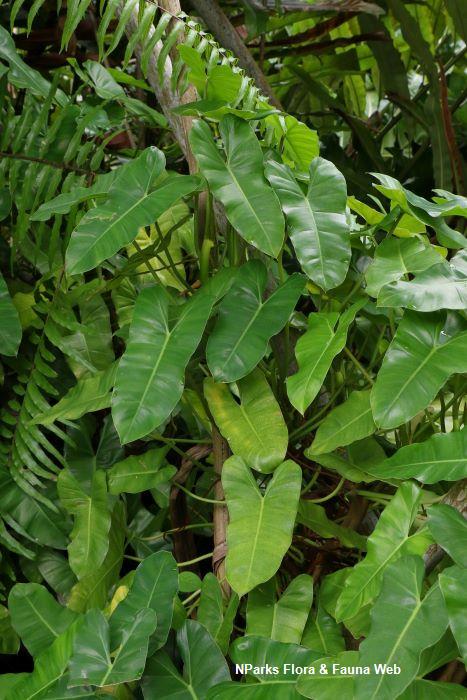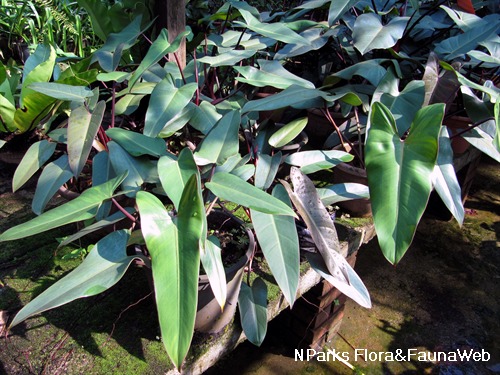.jpg)
Back
Philodendron 'Pink Princess'
| Family Name: | Araceae |
| Common Name: | Philodendron Pink Princess |
The Philodendron 'Pink Princess' has vibrant contrast of pink and dark green on the leaves, making this variegated plant an attractive ornamental to grow in homes or any indoor gardens.
Name
Classifications and Characteristics
| Plant Division | Angiosperms (Flowering Seed Plants) |
|---|---|
| Plant Growth Form | Climber, Epiphyte |
| Lifespan (in Singapore) | Perennial |
| Mode of Nutrition | Autotrophic |
Biogeography
| Native Distribution | Pink Princess is a cultivar of Philodendron erubescens which the species originates from Colombia. |
|---|---|
| Native Habitat | Terrestrial |
| Preferred Climate Zone | Tropical |
| Local Conservation Status | Non-native (Horticultural / Cultivated Only) |
Description and Ethnobotany
| Growth Form | This plant is a vining climbers that can be grown as shrub when young. Plant can grow up to 60 cm long. |
|---|---|
| Foliage | Glossy, leathery, evergreen, simple leaves with variegation of bright pink and dark green. |
| Stems | Reddish stem |
| Flowers | The inflorescence is of white spadix, surrounded by deep pink spathe. |
| Fruit | Fruit has not been seen in cultivation |
| Habitat | Plant is horticulturally cultivated under bright, indirect light with high humidity. |
| Similar | Similar to 'Pink Congo' but 'Pink Congo' has pointier leaves and its entire leaves are in bright pink. |
| Cultivation | Plant requires support for growth, due to its climbing habit. Grow in well-drained soil. Water when about 5 cm of soil from the surface is completely dry, ensuring excess water is fully drained out from the bottom of pot. Do not allow water to sit in pot saucer. Plant grows best under bright but indirect sunlight and enjoys high humidity. One way to ensure high humidity is by placing plants near each other. Fertilize once a month. Prune to help maintain plant in shape. Prune just above variegated leaf to assist in maintaining balanced variegation. |
| Etymology | Genus Philodendron means tree-loving, which refers to the epiphytic habit of aroid. |
Landscaping Features
| Landscaping | Ideal for growing indoors or gardens under bright, indirect sunlight. |
|---|---|
| Desirable Plant Features | Ornamental Foliage, Ornamental Stems |
| Landscape Uses | Interiorscape/ Indoor Plant, Small Gardens |
| Usage Hazard - Cons | Irritant - Sap, Toxic Upon Ingestion |
Plant Care and Propagation
| Light Preference | Semi-Shade, [Remarks] (Plant grows best under bright, indirect sunlight. Placing the plant under direct hot sun will cause burn damage to the leaves. ) |
|---|---|
| Water Preference | Moderate Water |
| Plant Growth Rate | Moderate |
| Rootzone Tolerance | Easy to Grow, Fertile Loamy Soils, Moist Soils, Well-Drained Soils |
| Maintenance Requirements | Moderate |
| Pruning | To produce a bushier plant, prune above the node to promote new growth. |
| Propagation Method | Stem Cutting |
| Propagation Method Remarks | Stem cuttings can be dipped in water or directly onto soil. Ensure the stem has at least one leaf and one node. New roots and new buds will grow from the node. If plant directly onto soil, place a plastic bag over the pot to create a greenhouse effect and to ensure high humidity for rooting to take place. Rooting may occur after about 4-5 weeks. |
Foliar
| Foliage Retention | Evergreen |
|---|---|
| Mature Foliage Colour(s) | Green, Pink |
| Mature Foliage Texture(s) | Glossy / Shiny, Leathery |
| Prominent Young Flush Colour(s) | Pink, Green |
| Young Flush Texture(s) | Glossy / Shiny |
| Foliar Type | Simple / Unifoliate |
| Foliar Arrangement Along Stem | Spiral |
| Foliar Attachment to Stem | Petiolate |
| Foliar Shape(s) | Non-Palm Foliage (Cordate) |
| Foliar Venation | Pinnate / Net |
| Foliar Margin | Entire |
| Foliar Apex - Tip | Acute |
| Foliar Base | Cordate |
Non - Foliar and Storage
| Stem Type & Modification | Herbaceous |
|---|---|
| Root Type | Aboveground (Aerial Root) |
Floral (Angiosperm)
| Flower & Plant Sexuality | Bisexual Flowers |
| Flower Colour(s) | White |
|---|---|
| Flower Grouping | Cluster / Inflorescence |
| Flower Location | Axillary |
| Flower Symmetry | Radial |
| Inflorescence Type | Spathe & Spadix |
| Flowering Habit | Polycarpic |
Fruit, Seed and Spore
| Fruit Classification | Aggregate Fruit (Syncarp) |
|---|---|
| Fruit Type | Fleshy Fruit , Berry |
References
| References | https://www.rhs.org.uk/plants/272080/philodendron-pink-princess-(v)/details |
|---|
Image Repository
Others
| Master ID | 34128 |
|---|---|
| Species ID | 8541 |
| Flora Disclaimer | The information in this website has been compiled from reliable sources, such as reference works on medicinal plants. It is not a substitute for medical advice or treatment and NParks does not purport to provide any medical advice. Readers should always consult his/her physician before using or consuming a plant for medicinal purposes. |

.jpg)
.jpg)
.jpg)



